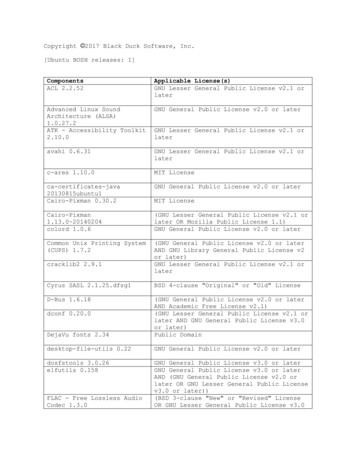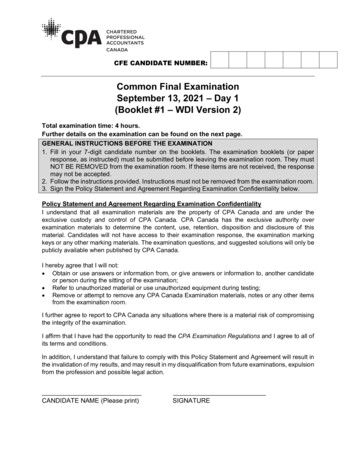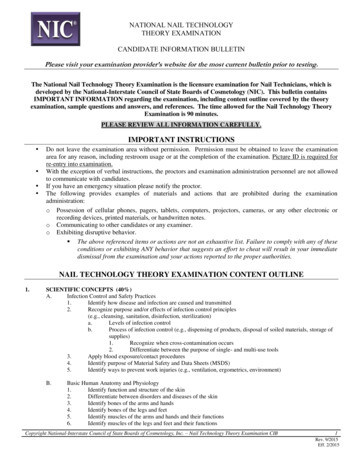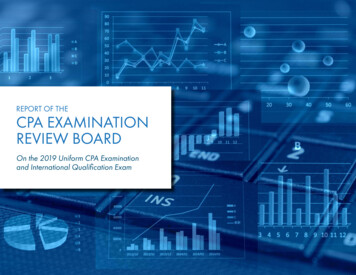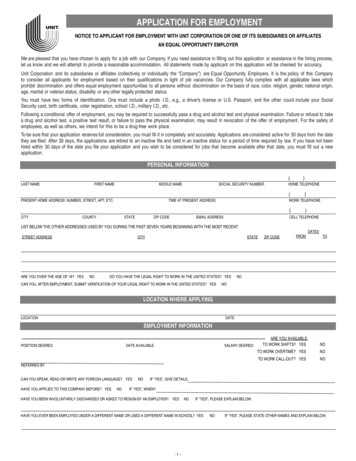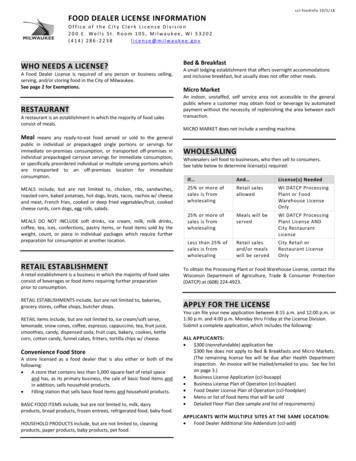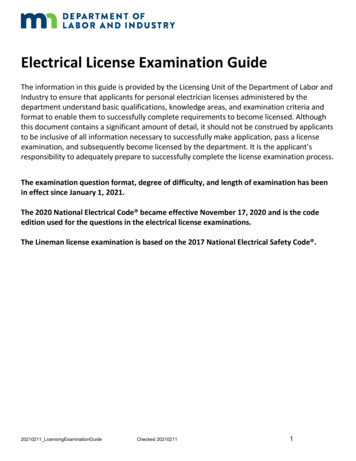
Transcription
Electrical License Examination GuideThe information in this guide is provided by the Licensing Unit of the Department of Labor andIndustry to ensure that applicants for personal electrician licenses administered by thedepartment understand basic qualifications, knowledge areas, and examination criteria andformat to enable them to successfully complete requirements to become licensed. Althoughthis document contains a significant amount of detail, it should not be construed by applicantsto be inclusive of all information necessary to successfully make application, pass a licenseexamination, and subsequently become licensed by the department. It is the applicant’sresponsibility to adequately prepare to successfully complete the license examination process.The examination question format, degree of difficulty, and length of examination has beenin effect since January 1, 2021.The 2020 National Electrical Code became effective November 17, 2020 and is the codeedition used for the questions in the electrical license examinations.The Lineman license examination is based on the 2017 National Electrical Safety Code .20210211 LicensingExaminationGuideChecked 202102111
Table of ContentsLicense Examination:PurposeGeneralQuestion FormatDegree of DifficultyLength of ExaminationExamination ResultsExamination Review or AppealPage 3Page 3Page 3Page 4Page 4Page 5Page 5Page 5Sample Questions:Page 6Formulas and Sample Calculations:Page 7Examination Knowledge Areas:Page 19American’s With Disabilities Act:Page 28Scheduling Examinations:Page 30Qualifications for License Applicants:Electrical Engineering DegreeTechnical College Program CreditMilitary ExperiencePractical Experience Acceptable to the DepartmentExperience Requirements by License TypeQualification for Satellite System Installer ApplicantsPage 31Page 31Page 31Page 31Page 31Page 31Page 31Reciprocal Licenses:Page 32Continuing Education Requirement Overview:Page 33Personal License and Examination Application:Page 3320210211 LicensingExaminationGuideChecked 202102112
License ExaminationPurposeSuccessfully completing a license examination provides evidence that the applicant possesses the necessaryknowledge and expertise to be licensed in a specific profession or for a specific scope of work within aprofession.Licensing examinations are designed to assess the applicant’s competence after they have completed theirqualifying education, training and experience. Licensing examinations are designed to assess higher level skillsthan academic examinations by assessing the applicant’s ability to apply the competencies they gained fromtheir education, training and experience in actual practice.Licensing examinations are intended to assure the public that the person passing an examination is qualified topractice within the scope of the license without causing harm to the public.The purpose of this license examination guide is to provide applicants with awareness of knowledge areascovered by specific license examinations, question and examination format, degree of difficulty for specificlicense examinations, length of examination and length of time allowed to complete their examination.Applicants are encouraged to review this entire guide to ensure their understanding of the examination processand governing rules.GeneralA copy of the National Electrical Code or the National Electrical Safety Code book is provided in the soft-coverformat and does not include tabs or other aids. The edition of the National Electrical Code is the edition adoptedas part of the state building code at the time the examination is administered. The edition of the NationalElectrical Safety Code is the most current edition at the time the examination is administered. The electroniccalculator is of the common desk type that includes addition, subtraction, multiplication, division, square root,and percentage functions. The Laws and Rules Booklet provided for the examination is in the Department’scurrent format and represents the laws and rules in effect at the time the examination is administered.1. Examination instructions are intended to be clear, concise and complete. No questions may be asked of theexamination proctor (test administrator).2. Applicants should understand the question without having to read the answer selections.3. Examination questions relate to knowledge areas within the scope of the applicable license.4. Examination questions reasonably cover the knowledge areas within the scope of the applicable license.5. Examination questions relate to knowledge areas that are common. The examination knowledge areas arewithin the areas of work generally experienced by applicants for, or persons holding, the class of theapplicable license.6. Applicants are allowed to use the National Electrical Code or National Electrical Safety Code (used only forthe lineman examination), a Laws and Rules Booklet, and an electronic calculator during their entireexamination. Unless code references are specifically required by an individual question, no code referencesare required as part of any answer. All reference materials and a calculator are provided by the Department.No other materials or electronic devices, including cell phones, are allowed in the building. Althoughreference materials are available for the entire examination, applicants should be adequately prepared andnot rely on provided reference materials to answer all questions. The majority of questions are intended tobe answered without the applicant needing to refer to reference materials.20210211 LicensingExaminationGuideChecked 202102113
7. Applicants observed giving or receiving assistance from other applicants or outside parties shall beautomatically failed and required to submit a new application, including submission of required fees.8. Applicants observed copying questions or making notes regarding questions shall be automatically failed andrequired to submit a new application, including submission of required fees.9. During their examination, applicants may leave the examination room to use the restroom, but are notpermitted to leave the building. Applicants leaving the building prior to completing their examination shall beautomatically failed and required to submit a new application, including submission of required fees.10. In addition to being monitored by the on-site proctor, the examination room may be electronically monitored.11. Examination materials, including completed examinations and scoring keys, are classified as nonpublic byMinnesota Statutes section 13.34. Applicants will only be provided with access to examination materialsduring the time they are being examined.Question Format1. Examination questions are formatted in a manner that requires the applicant to demonstrate mastery of theknowledge area.2. Variables in a question ensure that the appropriate knowledge area(s) or code rule(s) must be applied toarrive at the correct answer.3. Multiple-choice answer selections for knowledge areas with multiple conditions or requirements are wordedin a manner that requires the applicant to demonstrate knowledge of the subject matter and minimize theapplicant’s opportunity to select a correct answer(s) based on key words.4. Questions with a negative-response format such as “which of the following does NOT apply,” are only used inlimited instances. This is a companion format to the multiple-correct answer format identified in 3 above.5. Incorrect multiple-choice answer selections are “plausible.”6. Questions may include extraneous information.7. Unless stated otherwise in specific questions, all questions and related answers assume a “unity” powerfactor.8. Some questions relate to code violations repeatedly made by installers of electrical wiring. Practicalexperience must be augmented by quality training to ensure the applicant’s complete and accurateunderstanding of electrical code and theory.Degree of Difficulty1. Each examination question is assigned a degree of difficulty rating from 1 to 5, with 5 being the mostdifficult. “Degree of difficulty” as used in administration of the department’s license examinations hasno relationship to academic “grade point average” achievement.2. Questions rated least difficult (lowest) are those that relate to a single knowledge area, such asdefinitions or those requiring the application of a single code rule, or do not require complexmathematical calculations.3. Questions rated most difficult (highest) are those that require the application of multiple code rules orrequire multiple or complex mathematical calculations.4. Each examination is assigned a degree of difficulty range that is commensurate with the responsibilityor authority of the applicable license.5. Approximately 50% of specific license examination questions have a degree of difficulty within theoverall “degree of difficulty” range for the license type.20210211 LicensingExaminationGuideChecked 202102114
6. The examination for those license types that allow the holder of the license to be the “responsiblelicensed person” for an employer or contractor have an average degree of difficulty range between 2.5to 3.5. This category includes Class A master electrician, master elevator constructor, maintenanceelectrician, satellite system installer and power limited technician.7. The examination for those license types that require the license holder to be provided with generalsupervision by a person holding a license type identified in 6 above have an average degree of difficultyrange between 1.5 to 2.5. These license types include Class A journeyworker and elevator constructor.8. The examinations for Class B installer and lineman have an average degree of difficulty range between1.5 to 2.5.9. Examination questions are structured to use words and phrases appropriate to the license, withoutusing non-electrical code and theory terms that would unnecessarily increase the degree of difficulty.Length of Examination1. The license examinations for the Class A master electrician and the Class A journeyworker electricianconsists of 80 questions.2. The license examination for the power limited technician consists of 80 questions.3. The license examinations for the maintenance electrician consists of 70 questions, and lineman consistof 50 questions.4. The license examination for the Class B and satellite system installer licenses consist of 25 questions.5. Unless stated otherwise, all examination questions have the same point value. Partial points are notgiven - either full point credit or zero point credit is awarded for each question.6. The passing score for all examination is 70 percent.7. The time allowed to complete all examinations is 5½ hours.Examination Results1. Examination results are e-mailed and mailed to applicants generally within two weeks of the examination.Examination results are not provided to applicants by telephone.2. Examination result letters mailed to applicants who passed their examinations will contain directions onhow to obtain their license.3. Examination result letters mailed to applicants who failed their examinations will contain directions onhow to make subsequent application.Examination Review or Appeal1. Examinations with scores within five (5) percentage points of passing are rechecked to ensure accuracy.2. Written or oral reviews of individual examinations are not available to applicants. Applicants mayprovide written comment to the Department’s licensing unit on specific examination questions.3. Applicants who fail any examination may submit an application to retake the examination 30 days afternotification that they failed their examination.20210211 LicensingExaminationGuideChecked 202102115
Sample QuestionsThe sample questions are intended to identify the various question formats that are used in theexaminations. The knowledge areas used in the sample questions may not be applicable to all classes ofexamination.1) Which one of the following conditions apply where Type NM cables are permitted to enter apanelboard through a nonflexible raceway without the cables being secured to the panelboard?AThe raceway extends directly above the enclosure without penetrating the structuralceiling.BBecause the cables are not secured to the enclosure with a fitting, they shall bestrapped within 24-inches, measured along the cable sheath, of the outer end of theraceway.CDThe raceway shall be at least 18-inches, but not more than 130-inches long.The number of cables installed in the raceway is not limited where the raceway length isnot more than 24-inches.Answer: ANEC 312.5(C)This question demonstrates a “single correct answer” multiple-choice question format.2) Which of the four statements listed below does NOT correctly state code requirements pertainingto the installation of receptacle outlets installed to serve countertop surfaces in the kitchen of adwelling unit located in a multifamily dwelling?A receptacle outlet shall be installed at each wall counter space that is 12-inches orAwider.The required receptacle outlets shall be supplied by not less than two small-applianceBbranch circuits.If located above, the receptacle outlets shall not be located more than 20-inches aboveCthe counter top.Only receptacle outlets installed within 6-inches of the outside edge of the sink(s) shall beDrequired to be provided with ground-fault circuit-interrupter protection for personnel.Answer: DNEC 210.52This question demonstrates a “negative-response” multiple-choice question format.3) A feeder supplies three 460-volt, three-phase, 1740 RPM, Design B, alternating-current motors.The motors have the following nameplate ratings: 25 horsepower, 28.4 amperes; 15 horsepower,18.2 amperes; and 10 horsepower, 11.3 amperes. Assuming all the motors are operating undercontinuous duty, what minimum size XHHW-2 copper feeder circuit conductors are required tosupply the motor load? The conductor terminations are rated at 75 C.2 AWGA3 AWGB4 AWGC6 AWGDAnswer: 4 AWGNEC 430.6, 430.24, 430.250, 310.16This question demonstrates an “absolute” multiple-choice question format.20210211 LicensingExaminationGuideChecked 202102116
4) When a single equipment grounding conductor is run with multiple branch circuits in the sameraceway or cable, how shall it be sized?The equipment grounding conductor shall be sized for the average rating of all theAovercurrent devices protecting the conductors in the raceway or cable.The equipment grounding conductor shall be sized for the sum of all the overcurrentBdevices protecting the conductors in the raceway or cable.The equipment grounding conductor shall not be smaller than 10 AWG.CThe equipment grounding conductor shall be sized for the largest overcurrent deviceDprotecting the conductors in the raceway or cable.Answer: DNEC 250.122(C)This question demonstrates a “common” multiple-choice question format.Formulas and Sample CalculationsThe following information includes brief explanation and example of basic electrical formulas and calculationsand is not intended to be inclusive of all formulas and calculations applicants need to be familiar with tosuccessfully perform electrical work or receive a passing score on any license examination administered by theDepartment. Examples of more complex code calculations can be found in Annex D of the National ElectricalCode as well as in other resources. Knowledge gained through practical experience is generally not adequate toenable an applicant to pass an electrical licensing examination. It is the responsibility of an applicant toadequately prepare themselves, either through formal training or informal self-help training.Units of Measurement:The measurement system of preference for the National Electrical Code (Code) is now metric units inaccordance with the modernized metric system known as the International System of Units (SI). The SI unitsappear first, followed by the inch-pound units in parentheses. This same system also applies to the Tables inChapter 9 and the Annexes.Compliance with the numbers shown in either the SI system or the inch-pound system constitutes compliancewith the Code. Because most applicants are more familiar with the inch-pound units, all questions and answersin department license examinations use the inch-pound unit system. Answers for “absolute answer” formatquestions may be provided in either SI units or in inch-pound units.Percentages, Ratios and Equations:Electrical codes often give exact specifications based on exact criteria, then require that these specifications beadjusted if the circumstances differ from the criteria which the exact specifications were based on. In manycases, the original specified value is to be adjusted by a percentage. An example would be the ampacityadjustment factors for conductors. In other cases, the Code gives the applicable percentage to be used in designcalculations. Examples of this would be applying demand factors, adjusting for continuous load or selectingovercurrent protection for motors or transformers. A percentage is defined as a ratio of a whole number to 100.The number value, including any decimal of this ratio, is multiplied by 100 and assigned the % sign.20210211 LicensingExaminationGuideChecked 202102117
Sample Percentage Questions:1) What is 70% of 140? The percentage amount is divided by 100 to obtain the decimal equivalent: (70 100 .70)140 is multiplied by .70 (140 x .70 98)Answer: 70% of 140 982) What is the result of increasing 120 by 25%? The percentage amount is divided by 100 (25 100 .25)120 is multiplied by .25 (120 x .25 30)30 is then added to the original value of 120 (30 120 150)Answer: 120 x 1.25 150Sample Ratio Question:A ratio is defined as a fixed comparison or proportion between two similar values, such as primarycompared to secondary or input compared to output.1) A single-phase transformer has a nameplate voltage rating of 480/120. What is the ratio of theprimary voltage to the secondary voltage? The primary voltage is divided by the secondary voltage (480 120 4)Answer: The ratio of the primary voltage to the secondary voltage is 4:1How to transpose equations:Formulas used in code and theory calculations are in the form of equations. An equation is a statementof equality of two quantities of variables, such as A x B C. While it is important to remember thedefinition of an equation, it is more important to know how to transpose an equation that is notexpressed as being equal to the variable that is unknown. As an example, Ohm’s law and Watt’s lawcontain three variables that can be transposed into 10 other equations. Equations (formulas) can betransposed by one or more of the following operations performed equally on each side of the equal sign( ): addition, subtraction, multiplication or division.Two things to remember: A variable divided by itself equals 1; and Multiplying a variable by 1 does not change the variable and is not shown in the final equation1) If A x B C. Solve for A. To transpose this formula we divide both sides of the equation by B (A x B) B C BB B 1Ax1 C BAnswer: A C B20210211 LicensingExaminationGuideChecked 202102118
Ohm’s Law (E I x R):Ohm’s law expresses the relationship of three variables, E, I and R. The electromotive force in volts isrepresented by the letter E, the current in amperes is represented by the letter I, and the resistance inohms is represented by the letter R.In certain alternating current circuits, the term impedance is used rather than resistance. Impedance is acombination of resistance and reactance and is represented by the letter Z.1) In a series circuit, the voltage dropped across a 30 Ω resistor is 75-volts. What is the current of thecircuit? If E I x R, then I E RI 75 30Answer: I 2.5 amperesWatt’s Law (P E x I)Watt’s law expresses the relationship of three variables, P, E, and I. The power of an electrical circuit inwatts is represented by the letter P, the electromotive force in volts is represented by the letter E, andthe current in amperes is represented by the letter I. Watts is the term for the true power being used inan electrical circuit. True power is only produced when the voltage and current sine waves are botheither positive or negative, referred to as a unity power factor. The product of E x I must be a positivenumber for watts to be produced. A positive number times a negative number results in a negativenumber. As an example: (pos x pos pos), neg x neg pos), (neg x pos neg)1) An electric baseboard heater is rated 1500 watts at 240-volts. What is the current drawn by theheater? If P E X I, then I P EI 1500 240Answer: I 6.25 amperesResistance in Series and Parallel CircuitsFor the purposes of this discussion of resistance, direct current circuits and alternating circuits that donot contain inductive or capacitive loads (unity power factor) are used.In a series circuit, the current is the same at any point in the circuit, the total resistance is the sum of theindividual resistors, and the applied voltage is equal to the sum of the voltage dropped across all theresistors.1) A series circuit, consists of three resistors valued at 20 Ω, 40 Ω, and 60 Ω respectively. If the currentof the circuit is 2 amperes, what is the source voltage? If E I x RR total R1 R2 R3R total 20 40 60 then R total 120 ΩE 2 x 120Answer: E 240 volts20210211 LicensingExaminationGuideChecked 202102119
A parallel circuit is a circuit with more than one path for current flow. The total flow in the circuit isequal to the sum of the currents in all the branches. The voltage drop across any branch of the parallelcircuit is equal to the voltage applied to the parallel branch.There are three methods of determining the total resistance in a parallel circuit.1) When resistors of equal value are connected in parallel, the total resistance is equal to the value ofthe resistance of the resistor divided by the number of resistors.1) What is the total resistance of three 15 Ω resistors connected in parallel? R total R NR total 15 3Answer: RT 5Ω2) The product over sum method can be used for two different resistance values. In a circuit with morethan two resistors or branches, the product over sum method can be used sequentially until onlyone pair of resistors is left. For example: RT (R1 x R2) (R1 R2)What is the total resistance of a 20 Ω and a 30 Ω resistor connected in parallel? RT (R1 x R2) (R1 R2)RT (20 x 30) (20 30)RT 600 50Answer: RT 12 Ω3) The third method is the reciprocal method. The total resistance of a parallel circuit is equal to thereciprocal of the sum of the reciprocals of the resistor values.1 1 1 1RTR1R2R3What is the total resistance of a 2 Ω, 4 Ω and 8 Ω resistor connected in parallel?1 1 1 1RT2481 .5 .25 .125RT1 .875RTRT 1.875Answer: RT 1.143 Ω20210211 LicensingExaminationGuideChecked 2021021110
Volt-Amperes (VA) and Kilo-Volt-Amperes (KVA)For single- phase loads, the volt-amperes are simply the product of multiplying the voltage times thecurrent. In most cases the Code uses the term volt-amperes in lieu of watts. “Watts” generally is thevolt-amperes multiplied by the power factor of the circuit because it takes into account that current andvoltage may not always be in-phase or in unity. A power factor for other than resistive loads is normallyless than unity or 100% and will result in less usable power or energy. The volt-ampere load of analternating current circuit is also called “apparent power,” as it appears the circuit is producing powerequal to the volts times the amperes. Since this number can be quite large, the term KVA is sometimesused. One KVA is equal to 1000 volt-amperes.Single- Phase: KVA E x I1000For three-phase calculations, the volt-amperes are multiplied by 1.732 (square root of 3).Three- Phase: KVA E x I x 1.7321000Voltage Drop CalculationsWhile the Code does not mandate a specific allowable amount of voltage drop on feeders and branchcircuits, it does recommend that the total voltage drop not exceed five percent for reasonable efficiencyof operation. In addition, the recommendation states that the feeders and branch circuit should have amaximum of three percent. If the feeder circuit had two percent, the branch circuit could have threepercent or if the branch circuit had two percent, the feeder could have three percent. The voltage dropcalculation is an application of Ohm’s law. The voltage drop is equal to the current times the resistanceof the circuit. Determining the resistance of the circuit is the problematic part of the equation. The size,material, and length of the circuit conductors determine the total resistance.Each set of parallel conductors must be considered as one conductor when calculating voltage drop. Thevoltage drop calculations presented here result in an approximate voltage drop for alternating currentcircuits. Skin-effect, power factor, and harmonics are factors not taken into consideration in theseexamples. The formulas described below should not be relied on for the design of large feeders orfeeders for inductive or harmonic loads.Single-phase formulas:1) The first formula is: VD 1Ø (2 x K x I x L) CMWhere K is a constant of the ohms per mil foot, I is the circuit current in amperes, L is the lengthof the circuit in one direction and CM is the circular mil area of the conductors from NECChapter 9, Table 8. The “ohms per mil foot” is defined as the resistance of a conductor, one footlong and one circular mil of area. A mil is .001 of an inch.2) The second formula is: VD 1Ø (2 x R x I x L) 1000Where R is equal to the ohms per 1000 feet of conductor from NEC Chapter 9, Table 8, I is thecircuit current in amperes and L is the length of the circuit in one direction.The voltage drop of a three- phase circuit is slightly less than that of a single- phase circuit asonly one of the three conductors is at maximum current at any given time.20210211 LicensingExaminationGuideChecked 2021021111
Three-phase formulas:If you are using either VD 1Ø (2 x K x I x L) CM or VD 1Ø (2 x R x I x L) 1000, these formulas aremodified as follows for three-phase applications: VD 3Ø (1.732 x K x I x L) CM VD 3Ø (1.732 x R x I x L) 10001) What is the voltage drop on a 240-volt, single-phase circuit, that is 150 feet from thepanelboard, has a current of 28 amperes and No.8 THWN copper conductors? Use K 12.8VD 1Ø (2 x K x I x L) CMVD 1Ø (2 x 12.8 x 28 x 150) 16510VD 1Ø 107520 16510Answer: VD 1Ø 6.5 –volts2) What is the voltage drop on a 208-volt, three-phase branch circuit, that is 205 feet from thepanelboard, has a current of 33 amperes, and the conductors have a resistance of .510 Ωper 1000 feet? VD 3Ø (1.732 x R x I x L) 1000VD 3Ø (1.732 x .510 x 33 x 205) 1000VD 3Ø 5976 1000Answer: VD 3Ø 5.98 voltsPercentage of Voltage Drop1) What is the percentage of voltage drop on a 480 volt, three-phase, feeder circuit, that is 280 feetfrom the service equipment to the panelboard, has a current of 135 amperes, and 250 kcmil XHHW2 aluminum conductors? Use K 21.1VD 3Ø (1.732 x K x I x L) CMVD 3Ø (1.732 x 21.1 x 135 x 280) 250,000VD 3Ø (1,381,409 250,000)VD 3Ø 5.53 voltsPercent of VD VD EL-L x 100Percent of VD 5.53 480 x 100Percent of VD .01152 x 100Answer: Percent of VD 1.15%Transformer RatingsTransformers are commonly rated in KVA. The term KVA is a measure of apparent power in units of1000 volt-amperes. The term KVA is not to be confused with KW (kilo-watts). KW is a measure of truepower units of 1000 watts. Even though there are some losses associated with transformers, for generalcalculations the KVA of the primary is considered equal to the KVA of the secondary. The nameplate ofthe transformer generally includes the KVA rating, primary and secondary voltages or combinations, themanufacturer’s name, temperature rise, percent of impedance and if it is single- or three-phase.Single-Phase KVA E x I100020210211 LicensingExaminationGuideChecked 20210211Three-Phase KVA E x I x 1.732100012
1) Single-Phase Example: A 25 KVA, single-phase transformer is rated 480-120/240 volts. What is thefull load, primary current rating? 1Ø KVA (E x I) 1000I (KVA x 1000) EI (25 X 1000) 480I 25000 480Answer: I 52 amperes2) Three-Phase Example: For three-phase loads the KVA rating is equal the voltage times the currenttimes 1.732. A three-phase, 750 KVA transformer is rated at 4160-208/120 volts. What is the fullload, secondary current rating? 3Ø KVA E x I X 1.732 1000I (KVA x 1000) (E x 1.732)I (750 x 1000) (208 x 1.732)I 750000 360.26Answer: I 2081 amperesTransformer Short-Circuit Fault Current CalculationsThe available short-circuit fault current value must be known to properly select equipment ratings.Although there are a number of factors that will affect the available short-circuit fault current at anypoint on an electrical system, most calculations begin with determining the maximum available shortcircuit fault current at the load terminals of a transformer under a bolted short circuit condition withoutany short-circuit or overcurrent protection and assuming an infinite primary source. Only transformershort-circuit fault current calculations are demonstrated by the following examples. The formula formaximum available fault current for a transformer is:Short-circuit current [SC] transformer secondary full-load amperes [FLA] x the multiplierThe transformer multiplier is equal to 100 divided by the transformer impedance expressed as apercentage. The transformer impedance is generally marked on the nameplate of the transformer and isidentified by the letter “Z”.1) What is the maximum available short-circuit fault current for a transformer with the followingsecondary nameplate rating: 75 kva, 120/240 volt, single- phase, 2.5% Z?The transf
1. The license examinations for the Class A master electrician and the Class A journeyworker electrician consists of 80 questions. 2. The license examination for the power limited technician consists of 80 questions. 3. The license examinations for the maintenance electrician consists of 70 questions, and lineman consist of 50 questions. 4.


